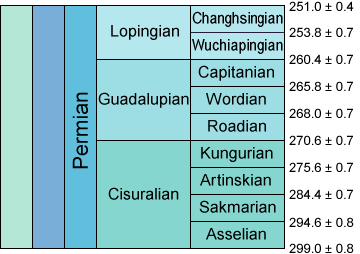Permian: At the end of the Permian was Greatest Extinction of All Time

The Permian period lasted from 290 to 248 million years ago and was the last period of the Paleozoic Era. The distinction between the Paleozoic and the Mesozoic is made at the end of the Permian in recognition of the largest mass extinction recorded in the history of life on Earth. It affected many groups of organisms in many different environments, but it affected marine communities the most by far, causing the extinction of most of the marine invertebrates of the time. Some groups survived the Permian mass extinction in greatly diminished numbers, but they never again reached the ecological dominance they once had, clearing the way for another group of sea life. On land, a relatively smaller extinction of diapsids and synapsids cleared the way for other forms to dominate, and led to what has been called the "Age of Dinosaurs". Also, the great forests of fern-like plants shifted to gymnosperms, plants with their offspring enclosed within seeds. Modern conifers, the most familiar gymnosperms of today, first appear in the fossil record of the Permian. In all, the Permian was the last of the time for some organisms and a pivotal point for others, and life on earth was never the same again.
 The global geography of the Permian included massive areas of land and water. By the beginning of the Permian, the motion of the Earth's crustal plates had brought much of the total land together, fused in a super-continent known as Pangaea. Many of the continents of today in somewhat intact form met in Pangaea (only Asia was broken up at the time), which stretched from the northern to the southern pole. Most of the rest of the surface area of the Earth was occupied by a corresponding single ocean, known as Panthalassa, with a smaller sea to the east of Pangaea known as Tethys.
The global geography of the Permian included massive areas of land and water. By the beginning of the Permian, the motion of the Earth's crustal plates had brought much of the total land together, fused in a super-continent known as Pangaea. Many of the continents of today in somewhat intact form met in Pangaea (only Asia was broken up at the time), which stretched from the northern to the southern pole. Most of the rest of the surface area of the Earth was occupied by a corresponding single ocean, known as Panthalassa, with a smaller sea to the east of Pangaea known as Tethys.
Models indicate that the interior regions of this vast continent were probably dry, with great seasonal fluctuations, because of the lack of the moderating effect of nearby bodies of water, and that only portions received rainfall throughout the year. The ocean itself still has little known about it. There are indications that the climate of the Earth shifted at this time, and that glaciation decreased, as the interiors of continents became drier.
Vast deserts covered western Pangaea during the Permian as reptiles spread across the face of the super-continent. 99% of all life perished during the extinction event that marked the end of the Paleozoic Era.
By the end of the Paleozoic Era, most of the oceans that had opened during the breakup of Panotia, were consumed as the continents collided to form the super-continent of Pangaea. Centered on the Equator, Pangaea stretched from the South Pole to the North Pole, and separated the Paleo-Tethys Ocean to the east, from the Panthalassic Ocean to the west.
During the Late Carboniferous and Early Permian the southern regions of Pangaea (southern South America and southern Africa, Antarctica, India, southern India, and Australia) were glaciated. Evidence of a north polar ice cap in eastern Siberia during the Late Permian has been found. The broad Central Pangaea mountain range formed an equatorial highland that during late Carboniferous was the locus of coal production in an equatorial rainy belt. By the mid-Permian, the Central Pangaea mountain range had moved northward into drier climates and the interior of North America and Northern Europe became desert-like as the continued uplift of the mountain range blocked moisture-laden equatorial winds.
The term "Pangaea" means "all land". Though we call the super-continent that formed at the-end of the Paleozoic Era, "Pangaea", this super-continent probably did not include all the landmasses that existed at that time. In the eastern hemisphere, on either side of the Paleo-Tethys Ocean, there were continents that were separated from the super-continent. These continents were North and South China, and a long "windshield-wiper"-shaped continent known as Cimmeria.
Cimmeria consisted of parts of Turkey, Iran, Afghanistan, Tibet, Indochina and Malaya. It appears to have rifted away from the Indo-Australian margin of Gondwana during the Late Carboniferous - Early Permian. Together with the Chinese continents, Cimmeria moved northwards towards Eurasia, ultimately colliding along the southern margin of Siberia during the late Triassic Period. It was only after the collision of these Asian fragments that all the world's landmasses were joined together in a super-continent deserving of the name "Pangaea".
Please click here to complete it